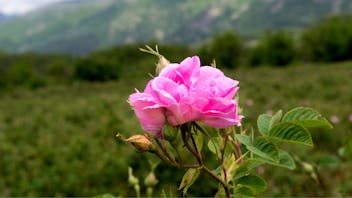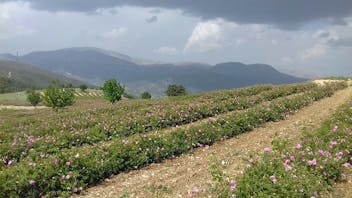Product Overview
Our Rose By-Absolute offers natural perfumers a dramatically different take on the Queen of Flowers! This unique extract, or ‘By-Absolute,’ is obtained from solvent extraction of the spent rose blossoms that remain after the hydrodistillation of Rose essential oil. The result is a warm, sweet floral, deep and slightly animalic, with notes of tart dried fruit, tea, and leather that last throughout the drydown. The oil is particularly effective in reconstitutions of Rose, Oudh, and Osmanthus as well as Amber and leather bases.
Utilizing the spent material after distillation of our Turkish-grown Rosa x damascena blossoms enables us to make the most of the Rose harvest and the wealth of aromatic molecules that are too large to pass through steam. The material is up-cycled through solvent extraction, yielding a semi-solid rose concrète. The concrète is then washed with ethanol to produce a mobile ‘by-absolute’ with an interesting and sensual range of concentrated aromatic constituents. This process makes for a more sustainable and cost-effective option when adding Rose to your blends.
“For its perfume, the Rose reigns supreme amongst the flowers of the world.”[1] Used throughout history for their exquisite, comforting and inspiring scent and visual beauty, Roses of every color and size are esteemed for being metaphorical 'heart openers.' With their multi-petaled intricacy, it is no surprise that Rose essential oils and absolutes are among those that have the most chemical complexity. And while many of the more than 400 chemical constituents[2] of Rosa damascena are present in mere trace amounts, they contribute immensely to the sublime and nuanced fragrance we know as Rose.
Our Rose By-Absolute lends interesting notes to natural perfume blends, especially in combination with Jasmine, Sandalwood, and Ylang Ylang. It is soluble in vegetal oil or perfumer’s alcohol and is very concentrated, so please dilute prior to use.
1 Genders, Roy. Scented Flora of the World, 1994, p. 396.
2 Rhind, Jennifer Peace. Fragrance and Wellbeing, 2014, p. 303.



